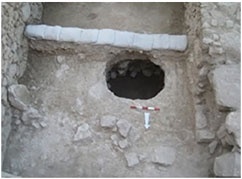Crossref Citations
This article has been cited by the following publications. This list is generated based on data provided by
Crossref.
Fuks, Daniel
Amichay, Oriya
and
Weiss, Ehud
2020.
Innovation or preservation? Abbasid aubergines, archaeobotany, and the Islamic Green Revolution.
Archaeological and Anthropological Sciences,
Vol. 12,
Issue. 2,
Avni, Gideon
2021.
Terraced Fields, Irrigation Systems and Agricultural Production in Early Islamic Palestine and Jordan.
Journal of Islamic Archaeology,
Vol. 7,
Issue. 2,
Langgut, Dafna
2022.
Mid-7th century BC human parasite remains from Jerusalem.
International Journal of Paleopathology,
Vol. 36,
Issue. ,
p.
1.
Namdar, Dvora
and
Ziffer, Irit
2022.
Advances in Fig Research and Sustainable Production.
p.
26.
Lev-Yadun, Simcha
2022.
Advances in Fig Research and Sustainable Production.
p.
11.
Forste, Kathleen M.
Marston, John M.
and
Hoffman, Tracy
2022.
Urban agricultural economy of the Early Islamic southern Levant: a case study of Ashkelon.
Vegetation History and Archaeobotany,
Vol. 31,
Issue. 6,
p.
623.
Peña-Chocarro, Leonor
and
Pérez-Jordà, Guillem
2023.
Plants from distant places: the 1st millennium ce archaeobotanical record from Iberia.
Vegetation History and Archaeobotany,
Orendi, Andrea
Yehuda, Elisabeth
Zeischka-Kenzler, Annette
and
Tal, Oren
2023.
Flora in the Latin East: Archaeobotanical Remains from Crusader Arsur.
Tel Aviv,
Vol. 50,
Issue. 2,
p.
263.
Cohen, Pnina
Bacilieri, Roberto
Ramos-Madrigal, Jazmín
Privman, Eyal
Boaretto, Elisabetta
Weber, Audrey
Fuks, Daniel
Weiss, Ehud
Erickson-Gini, Tali
Bucking, Scott
Tepper, Yotam
Cvikel, Deborah
Schmidt, Joshua
Gilbert, M. Thomas P.
Wales, Nathan
Bar-Oz, Guy
and
Meiri, Meirav
2023.
Ancient DNA from a lost Negev Highlands desert grape reveals a Late Antiquity wine lineage.
Proceedings of the National Academy of Sciences,
Vol. 120,
Issue. 17,
Fuks, Daniel
Melamed, Yoel
Langgut, Dafna
Erickson-Gini, Tali
Tepper, Yotam
Bar-Oz, Guy
and
Weiss, Ehud
2023.
Unprecedented yet gradual nature of first millennium CE intercontinental crop plant dispersal revealed in ancient Negev desert refuse.
eLife,
Vol. 12,
Issue. ,
Mir-Makhamad, Basira
and
Spengler, Robert N.
2023.
Testing the applicability of Watson’s Green Revolution concept in first millennium ce Central Asia.
Vegetation History and Archaeobotany,
Forste, Kathleen M.
Marston, John M.
Ramsay, Jennifer
and
Hoffman, Tracy
2024.
Cultivating the Hills and the Sands: A Comparative Archaeobotanical Investigation of Early Islamic Agriculture in Palestine.
Environmental Archaeology,
p.
1.
Fuks, Daniel
Schmidt, Frijda
García‐Collado, Maite I.
Besseiche, Margot
Payne, Neal
Bosi, Giovanna
Bouchaud, Charlène
Castiglioni, Elisabetta
Dabrowski, Vladimir
Frumin, Suembikya
Fuller, Dorian Q.
Hovsepyan, Roman
Muthukumaran, Sureshkumar
Peña-Chocarro, Leonor
Jordá, Guillem Pérez
Ros, Jérôme
Rottoli, Mauro
Ryan, Philippa
Spengler, Robert
Stevens, Chris J.
Valamoti, Soultana Maria
Weiss, Ehud
Alexander, Michelle
and
Gros-Balthazard, Muriel
2024.
Orphan crops of archaeology‐based crop history research.
PLANTS, PEOPLE, PLANET,
Rivera, Diego
Ferrer-Gallego, P. Pablo
Obón, Concepción
Alcaraz, Francisco
Laguna, Emilio
Goncharov, Nikolay P.
and
Kislev, Mordechai
2025.
Fossil or Non-Fossil: A Case Study in the Archaeological Wheat Triticum parvicoccum (Poaceae: Triticeae).
Genes,
Vol. 16,
Issue. 3,
p.
274.
Polisca, Federico
Dal Corso, Marta
Baldan, Maela
Bortolini, Mara
Battistel, Dario
Dal Sasso, Gregorio
Gherardi, Francesca
Canti, Matthew
Piazzalunga, Giorgio
and
Nicosia, Cristiano
2025.
Phosphatic crusts as macroscopic and microscopic proxies for identifying archaeological animal penning areas.
Journal of Archaeological Science,
Vol. 177,
Issue. ,
p.
106207.



